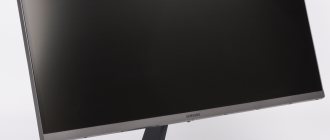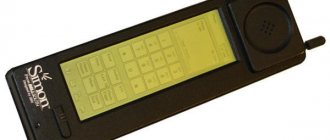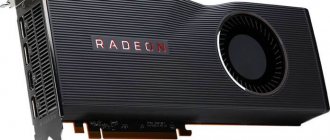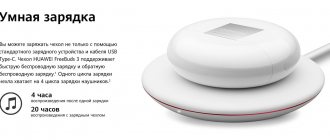What kind of projectors are there?
The main task of the device is to display a clearer, more colorful image on a wide screen. Projectors vary in size, class, purpose of use, and technical characteristics.
There are different types of projectors:
- Pocket - used for unplanned presentations. They are small in size, weighing no more than 350 g. Convenient for travel, mobile, but with limited functions.
- Portable – easy to carry, light weight, differs from pocket ones in a larger set of functions. They have high technical characteristics. They are used mainly for business meetings to promote products or present new projects.
- Stationary projectors are used in offices and home theaters. They are not mobile, require permanent installation, and are multifunctional. They have a high luminous flux. Equipped with additional equipment, interchangeable optics and the ability to display the image on a maximum screen size.
Based on technology, projectors are classified according to the following systems:
- LCD – based on three liquid crystal matrices (red, blue, green). The luminous flux is generated by the lamp and displayed on the screen. This is the most common type of projector and is reasonably priced. The disadvantages of the system include the presence of a grid effect in the image.
- DLP – functioning is carried out by the core (1 matrix). Using mirror lenses that rotate under the influence of a signal, the required image pixel is created. The picture turns out to be contrasty with clear shadow boundaries. The models are more durable, the price offer is from medium to high.
- CRT – optimal image quality, long service life. The projector is bulkier and requires special installation. The light flow is weak, use is possible only in complete darkness, the price is high. In home theaters, they are installed in a room specially designated for this purpose.
The projected image has become a good alternative to a TV.
The latest generation of projectors with new LCoS technology are based on liquid crystals on silicon. The imaging system is not translucent, but reflective. The picture turns out clear and realistic.
Advice! The technology has not yet found wide application; before choosing an LCoS system projector for a home theater, it is recommended to familiarize yourself with the technical characteristics or use the services of a consultant.
3D technology ensures realistic pictures
Modern projectors: features of choice
In the technology market, multimedia projectors are becoming increasingly popular. They are indispensable assistants in the office, educational institutions and at home. But what properties are most important when choosing such a device? As a rule, the focus in this case is the number of functions, the level of quality of the transmitted image, speed of operation, and color palette. A good projector can turn an ordinary home room into a real cinema. But this only happens when the decision is made correctly.
The catalog of models on the market is quite large. But it is quite possible to significantly narrow this range, taking into account some points. Let's take a closer look at them.
Sphere of purpose
When purchasing a multimedia device, it is very important to take into account the scope of its further use. Depending on the chosen option, the optimal technical characteristics will differ.
There are several types of projectors that are used for:
- Work (during conferences and presentations);
- Holding public events (concerts, show programs);
- For home use (home theater).
Brightness
An equally significant aspect that significantly affects the quality of display of materials on a large screen is brightness (the strength of the luminous flux that a multimedia device emits, this indicator is measured in lumens, ANSI).
Depending on the lighting level of the room, this indicator will vary from:
- 600 to 800 units (small room with complete darkness),
- 1000 – 1800 units (rooms with partial lighting,
- 2000-3000 units (working in daylight),
- 3000 units or more (without dimming in bright daylight for rooms with an area of no more than 100 sq.m.).
- 5000 units or more (without dimming in bright lighting for large halls),
- 10,000 and more – professional projectors for stadiums and concert halls.
Permission
This indicator characterizes the device’s ability to display a certain number of pixels (dots) on the screen per unit area. A higher value provides a clearer picture on a larger screen. At the same time, you should not strive for astronomical figures, because the quality of the image also depends on the resolution of the signal that is supplied to the projector for the image. The standard resolution of 600x800 pixels can be displayed losslessly in DVD quality. Resolutions of 1280x800 (HD) and 1920x1080 (FHD) will provide higher clarity; FullHD is the best option today.
Contrast
A very important indicator that is responsible for the so-called color depth. In other words, this property of the projector is reflected on a large screen when projecting an image in the most bright black and white colors. A weighted average between 800:1 and 1000:1 is considered optimal.
Other parameters of the projectors are very identical. Their differences are minimal. When deciding on a specific model, think about what additional functionality is important to you. For example, the “picture in picture” option, Wi-Fi, freeze frame, etc. It is very important to ensure the availability of connectors responsible for the input signal (HDMI input), lamp life and the cost of a spare when replacing.
Optimal parameters for a home cinema projector
Typically, the cost of film projectors is amazing. Nevertheless, it is quite possible for home use to choose an affordable option with good functional properties.
The optimal solution combines the following parameters:
- Brightness ranging from 100 to 2500 Lumens (the image will be saturated and quite bright),
- Availability of a built-in media player (you can watch movies from a flash drive),
- High level of performance,
- The presence of several ports to connect other devices, light weight,
- Availability of input for headphones and speakers,
- FHD resolution,
- Contrast from 4000:1,
- 3D support,
- Image rotation option.
- Possibility of connecting additional devices – tablets, smartphones, TVs.
What is better for the home – a projector or a TV?
The choice of a TV or projector for a home theater depends on the purpose of use and the desired image quality. A comparative description of the pros and cons will help you make your choice.
Projector advantages:
- The ability to watch images on a large screen in good quality for a relatively low price; a TV with this format will cost more.
- Insignificant strain on vision, light rays are directed at a white surface and are perceived in reflected form, light comes directly from the TV.
- The ability to change the format without losing the clarity and quality of the picture.
- The projector is compact, installation does not require a large area, and will fit into any interior without disturbing the design.
Disadvantages of a projection device:
- The viewing area should be dark; only if this condition is met will the image be of high quality.
- Reproduction of digital format only.
- The lamp has a limited life; in some models it cannot be replaced. If such a possibility is provided, it is not cheap.
- The need to purchase a speaker.
- Noisy fan operation.
Important! To view, preliminary preparation is required - darkening the room, installing a screen.
TV advantages:
- Lighting does not affect image quality.
- A large assortment for any family budget. Projectors are not so widely represented.
- There is no need to purchase related equipment.
- After installing the TV, no additional preparations are required.
- Doesn't make any extraneous noise.
Flaws:
- Model limited format. The larger the screen diagonal, the more expensive the TV.
- The eyes get tired from prolonged viewing, and the quality of vision decreases.
- Screen matrices are susceptible to mechanical stress.
- The models are bulky and heavy.
It’s definitely not possible to determine which is better – a TV or a projector. If your budget allows, you can purchase both devices. You can watch journalistic programs and news on TV, and films and sports broadcasts on the big screen of your home theater.
Balance between brightness and contrast
If you are using the projector at home or in an organization, but there is little lighting
, then such a projector, as a rule, needs 2000-2400 lumens of maximum brightness. In these conditions, the room is dark enough that the projector's contrast makes a noticeable difference to image quality, but there is still enough light that you won't be able to tell the difference between the most expensive high-end projector and a mid-range $2,000 projector. Therefore, for dimly lit rooms you need a projector with good contrast, but not too high.
How to choose a quality projector for your home instead of a TV
To choose a projector for watching movies at home, we focus primarily on the diagonal size of the picture. There is no point in purchasing a device with a small format; the main task is a large screen, the standard version is 16x9. Therefore, pocket models are not used instead of a TV; they have a different purpose.
A number of criteria apply to fixed home theater projectors, such as what type of light converter. Lamps are:
- Laser - capable of working for more than 6000 hours, in a completely dark room. The image quality will only be good on a white, flat surface.
- LED - their service life is 2 times less, but for picture quality they do not require complete dimming; their brightness starts at 900 lm.
- With laser and LED technology, the combined options produce up to 4000 lumens, which matches the brightness of a standard LCD TV.
The interior material for the home theater is chosen in dark colors so that it does not reflect light.
Important! Projector models with mercury lamps are often found, but manufacturers are gradually abandoning them.
Requirements for a home theater lamp: it must have a long service life and a brightness of at least 900 lm (the more, the better).
Pay attention to resolution and contrast. The second parameter is indicated in the characteristics. For a home theater, choose a 2000:1 projector. Regarding the first indicator:
- mandatory HD parameter (720p) mainly films and game consoles in this format;
- to idealize the picture, a matrix with Full HD (1080p) is recommended; it supports four-dimensional images, but the cost of such a model starts from 50 thousand rubles, which is not within the budget of every family;
- With the transition to digital, projectors with 4K format are gaining popularity. High-quality, clear, highly realistic picture - the technology is designed for large home theater screens.
An important point, especially for a home theater, is the correction of keystone errors (distortion). In a small apartment, this parameter plays a big role; it is indicated in degrees horizontally and diagonally. Allows you to install the projector on the side, the picture will remain rectangular.
Attention! Models of this type are more expensive, but can reproduce images on a 1 m screen from a distance of 30 cm from it.
And the last thing you should pay attention to when choosing a projector for watching movies in a home theater is the availability of the necessary connectors.
Contrast
Image contrast is the ratio of brightness of white to black. Unfortunately, it is not always possible to unambiguously link the real contrast of an image to that indicated in the specifications. In brightly lit rooms, contrast does not matter, since the “black” areas of the image are heavily illuminated even without the participation of a projector. The main recommendation for those who buy a projector for brightly lit rooms is to ignore this parameter, since the image contrast will be determined solely by the brightness
projector.
When choosing a projector for a darkened home theater, contrast is of utmost importance
. The better the room meets the requirements for a home theater, the less excess light falls on the screen and the closer the image contrast becomes to the contrast stated by the manufacturer of the projector itself (which was obtained in laboratory conditions).
As a result, in a home theater, the maximum brightness is limited to a level that is comfortable for the eyes and should not be too high. In these conditions, where the top bar is limited, the projector's contrast allows it to increase the dynamic range, or the number of gradations of brightness the projector is able to display. Also, the higher the contrast, the more the black looks like black rather than gray. With a low-contrast projector, this can be seen by a clearly visible “frame” of the image borders when displaying a completely black fill on the screen.
The contrast parameter depends on many factors, including the characteristics of the matrix. For example, Epson home theater projectors with C2 Fine matrix technology allow for significantly higher contrast levels. Again - only in complete darkness and with minimal stray light!
Another nuance is the use of automatic iris in projectors, a device that reduces the projector's brightness in dark scenes and provides deeper blacks. This feature is extremely useful, but its effect is achieved when displaying dark scenes without bright objects. This contrast is called "dynamic" or "on/off" contrast and is listed in the projector's specifications, which can be confusing. This is another example of why the characteristics specified by manufacturers are not always enough to understand the capabilities of the projector.
When working with dark scenes, the difference in technology also comes into play. For example, in the segment of the most inexpensive projectors, single-matrix DLP devices can provide higher contrast ratio, which will be accompanied by a noticeable “rainbow effect” (a bright colored trail when the eyes move across the screen) in dark scenes with contrasting objects.
Note from 03/04/2019 - there was a time when this was true. However, with the release of the Epson 5600 series projectors, even an inexpensive full HD 3LCD home theater projector model is able to achieve very impressive native contrast ratios ( i.e.
contrast ratio, without any “marketing tricks”) - 1500:1 or even 2000:1, depending on the brightness and operating mode (for comparison, the average IPS monitor has a real contrast of around 1000:1). Native contrast is the ratio of the light transmittance of the projector matrices in a completely closed position (when outputting a black screen) to fully open (when outputting a white field) without using various “techniques”, for example, such as the auto iris mentioned above. In fact, it’s already 2019, and the days of low-contrast 3LCD projectors have long since sunk into oblivion.
Which brand of projector to choose
To compile a rating of the best companies presenting projectors on the market, product evaluation criteria were identified:
- options;
- correspondence of price to quality;
- contrast;
- permission;
- availability of necessary connectors;
- lamp operating time and brightness.
International products, founded in 2014, meet all these requirements. Philippine representative of Epson. "Sony", "JVC" Japan. Mostly they choose a projector for Chinese homes;
Taiwanese brands “Benq” and “AsusTek Computer Inc” are deservedly popular for home cinemas. It occupies not the last place on the market.
What is a projector and how does it work?
Structurally, the projector is similar to a set-top box. In essence, this is how it is. It receives a signal as input, converts it and displays it on a special screen at the output. There can be many types of signal received, thanks to various ports and interfaces. You can connect a computer, video cameras, cameras, flash drives and much more. The image is projected onto a special roll-up wall screen for the projector. Although their types may be different.
The roll-up screen can be easily hidden in the case if necessary
Top 10 Best Home Theater Projectors of 2020
Projectors for home use, according to the 2020 rating, were combined into the top 10 best. When evaluating, reference was made to sales figures, price offer, quality and “intelligent” equipment. The top ten includes the following models.
Epson EH-TW5650
Projector brand:
- corrects keystone distortion;
- supports formats: 480i, 480p, 576i, 576p, 720p, 1080i, 1080p;
- provides 3D viewing;
- lamp – UHE, operating life – 4500 hours;
- contrast – 60000:1.
Portable type.
Cost – from 65 thousand rubles.
Epson EH-TW5650 is equipped with an HDMI input, a USB port, supports the aptX codec, Miracast, Bluetooth
Optoma UHD65
4K home theater projector, technology for large screens. Format 2716x1528 pixels. Laser and LED lamps with a long shelf life.
Price – from 260 thousand rubles.
Important! Not used for game consoles.
Optoma UHD65 has all sorts of outputs, a long focal length lens, silent cooling
Sony VPL-HW45ES
One of the best mid-range home theater projectors with LCoS technology. High-quality support for 3D content; a stationary model can be installed at any distance from the screen. Mercury lamp, service life 6000 hours. Supports all formats except 4K.
Sony VPL-HW45ES is equipped with the necessary inputs, weighs 9 kg
Price – from 105 thousand rubles.
LG HF85JS
Laser projector with long service life. In continuous mode, it can work in a home theater for more than 2.5 years. Short focus allows you to position it extremely close to the screen. Projector with full Smart-TV function. A system with a built-in video player reproduces information from a flash drive, smartphone, or wireless Internet. Supports 3D, rotation is done using the remote control.
The disadvantages of the LG HF85JS include the noise of the cooling system.
Price – from 108 thousand rubles.
NEC U300X
LED device for home cinema with a brightness of 3000 lm, lamp life of 3000 hours in economy mode. Supports: SXGA, UXGA, VGA; SVGA, WXGA, SXGA+. The basic format is 1024x768 (XGA). Contrast – 2000:1.
NEC U300X has all the necessary interfaces and inputs
Price – from 155 thousand rubles.
Xgimi H2
LED projector with the following characteristics:
- Full HD format (1920x1080);
- equipped with all interfaces;
- service life of the light source 3000 hours;
- built-in stereo system;
- picture clarity – 5000:1;
- reproduces 3D;
- silent.
The Xgimi H2 model is compact, with metal design elements, weighs 2.5 kg
Cost – from 60 thousand rubles.
JVC LX-UH1
3840x2160 4K format projector with a mercury lamp, light emitter service life - 4000 hours at a flux of 2000 lm. Contrast ratio 100000:1. The device is compatible with a computer and is equipped with the following interfaces:
- 2 HDMI inputs;
- video input Mini-D-sub 15 pin, VGA;
- USB socket, Mini-USB.
JVC LX-UH1 supports HDMI
Cost – from 160 thousand rubles.
Optoma UHL55 Black
Portable DLP model with HDTV support, resolution 3840×2160. Clarity – 250000:1, brightness – 2000 lm. There is a distortion correction function, the device is equipped with a loudspeaker. Lamp service life – 2000 hours.
Price – from 88 thousand rubles.
Optoma UHL55 Black supports Internet, 3D, Wi-Fi
Viewsonic LS700HD
HD type laser projector is quite popular in the mid-range market. The light source lasts 20,000 hours, the flux is 3500 lm.
Attention! One of the high-contrast projectors, repeated testing confirmed the figure - 3,000,000:1.
The housing design protects the device from dust, which increases its service life.
Cost – from 99 thousand rubles.
Viewsonic LS700HD supports 3D and HDTV, 17ms response time
LG HU80KSW
DLP laser projector with 8 segments, which completely eliminates the rainbow effect. The lamp life is 15,000 hours; if you watch 3-4 hours a day, the projector will last for 12 years. Equipped with all interfaces and necessary connectors. The compact projector supports HDR and is silent. Light flux – 2500 lm, contrast – 150000:1. The device is stationary and weighs about 7 kg.
LG HU80KSW is one of the expensive models
Price – from 176 thousand rubles.
High end projectors
This price category includes projectors costing from 60,000 to 120,000 rubles. In addition to price, the device is united by high power of the light source, high-quality optical components, good sound and wide multimedia capabilities.
LG HF80JS
Average cost - 110,000 ₽
The most expensive model in the review opens the rating - LG HF80JS. The device is equipped with a lampless laser emitter based on diodes, and the service life of these elements, according to the manufacturer, is 20 thousand hours. This means that when used daily to watch several films, the projector can last 12–15 years without replacing the optical element. The luminosity of 2000 lumens is enough to use the projector without creating darkening, and you can view content using a wired, wireless connection, USB drives or a PC connected via HDMI.
Epson EH-TW5650
Average cost - 66,500 ₽
This model uses a replaceable incandescent lamp as a light source, and its service life is 4500 hours in standard mode, at 2500 lm brightness. At the same time, the economy mode, which limits the brightness to 1650 lm, extends the life of the light source by 3000 hours. The standard resolution of the device matrix is Full HD. There are options for manual focusing, adjusting contrast, tone, color gamut, saturation and other image parameters. And the cost of the top product from Epson is 35% lower than that of the model from LG.
BenQ W2000+
Average cost - 59,000 ₽
The projector is deservedly placed in third place in the review. The device also uses an arc lamp as a source of light flux, and the brightness of the flux reaches 2200 lm. The lamp life is longer than that of the Epson model - 3500 hours at maximum brightness and 6000 hours in economy mode. The high-quality acoustics provided by two ten-watt speakers deserve attention - when watching movies, it is quite enough for a standard room.
LG PF1000U
Average cost - 77,500 ₽
The short throw LG PF1000U features long element life and great placement flexibility, allowing you to create a 100-inch diagonal projection in almost any room.
For a 60-inch image, it requires only 11 cm of focal length, and the LED element has a lifespan of 30,000 hours. Full HD, high image contrast, 80% uniformity - in all these indicators it corresponds to more expensive and less convenient competitor projectors. Why only fourth place? For an aperture of 1000 lm, which requires darkening the room for comfortable viewing of the video.
Acer H6517ST
Average cost - 53,500 ₽
Another short throw model completes the top 5 high-end home projectors. A resolution of 1920 x 1080 pixels, a gas-discharge lamp that operates for 4000 hours at a maximum brightness of 3000 lm, or 7 thousand hours in economy mode - these are quite serious characteristics. Add to this the minimum distance to the screen of 50 centimeters, the maximum diagonal of 7.62 m, and small dimensions - we get an excellent universal projector. True, the model does not support wireless networks, and the built-in two-watt speaker is not enough for normal video recording.
Rating of the best budget, inexpensive projectors for the home in 2020
Modern models with a set of necessary functions for high-quality viewing have a wide range of prices. You can choose a reliable projector for your home at an inexpensive price. Below are several economy class options.
UNIC YG-500
Model characteristics:
- format – 1080p;
- brightness – 1500 lm;
- contrast – 1000:1;
- LED lamp, service life – 30,000 hours;
- video formats – 3GP, AVI, MKV, FLV, MPG.
Price offer for UNIC YG-500 – from 6 thousand rubles.
SV-856 LED
LED class, equipped with all necessary inputs and interfaces. Lamp brightness – 1800 lm, image clarity – 1000:1. LCD matrix type. Resolution – 1920×1080. Focal length 1.3–4 m.
Price SV-856 LED – from 9.5 thousand rubles.
Acer X118
Portable DLP home theater projector with 800x600 resolution. LED beam former with brightness of 3600 lm. Contrast – 20000:1. Supports SECAM, PAL, NTSC. Equipped with the necessary inputs and interfaces.
The cost of Acer X118 is from 22 thousand rubles.
3D support
When displaying 3D from a computer, you need to be sure that the projector supports the stereo pair format you are sending to it. Example formats are “top-bottom”, “side-by-side”, “frame packing”. To display 3D Blu-ray discs, an HDMI interface version starting from 1.4 is required.
3D is supported to some degree by many projectors, although the best quality is provided by devices specifically designed for this task. Any 3D technology works due to the fact that an image not intended for it is hidden from each eye. For example, active glasses alternately cover either the left or the right eye with an LCD screen. This leads to a multiple drop in the brightness of the 3D image, which is the main problem of any 3D system. By combining the projector's inherently high peak brightness and color brightness with Epson's 480Hz Active Glasses technology, which reduces the time it takes for both doors to be closed, Epson 3D projectors deliver higher-brightness 3D images for brighter, more vibrant images.
Note from 03/04/2019 - the system of paired projects has been discontinued and is no longer sold, because we can safely assume that the “3D renaissance era” has successfully ended and for the vast majority of buyers (including in the field of business and installation) projectors with 3D are simply not interesting. Therefore, at the moment, only 3D projectors for home theater .
To be fair, I’ll tell you that back in 2016, there was still another interesting version of the solution, originally designed for 3D - the Epson EB-W16SK system of two paired EB-W16 projectors. Unlike conventional projectors, it used not active, but passive 3D glasses technology based on polarizing filters. Although the EB-W16SK system was more expensive than a separate 3D projector, and the passive technology required the purchase of a special screen, significant savings were achieved by purchasing cheap passive glasses (good active glasses cost around $100). For this reason, the EB-16SK was a good choice when it was necessary to demonstrate 3D to an entire class.
Rating of the best premium projectors for the home
Premium brands meet all modern requirements. The devices are characterized by high resolution, contrast, a set of all possible operations and a long service life. Models are presented with a wide price range. You can choose a video projector for your home according to your budget.
Dream Vision Yunzi 2
A device for a large home theater with LCoS technology and Full HD format. Luminous flux – 1200 lm. Image size up to 7 m. Picture clarity – 90000:1. Inputs – VGA, HDMI, supports all formats.
The cost of Dream Vision Yunzi 2 is from 420 thousand rubles.
BenQ W5700
DLP technology, home theater device. Image size up to 5 m. Resolution – 3840×2160. Brightness – 1800 lm. Contrast – 10000:1. Supports 3D, HDR, silent.
BenQ W5700 price – from 171.9 thousand rubles.
Xiaomi MiJia Laser Projection TV
The light flux generator is laser, with a brightness of 5000 lm. DLP technology with 1920x1080 format. Image clarity – 3000:1. Widescreen, silent. Reproduces HDMI format, equipped with all inputs and connectors. Bluetooth and WiFi are built in.
Xiaomi MiJia Laser Projection TV – stationary model weighing 7 kg
Cost – from 120 thousand rubles.
The Best Home Theater Protectors
Optoma HD144X
The average price is 38,000 rubles. Characteristics:
- portable widescreen projector
- DLP technology
- resolution 1920×1080 (Full HD)
- luminous flux 3200 lm
- contrast ratio 23000:1
- HDMI connection
- outputting images from USB flash drives
- 3D support
The list of home projectors in the 2020 rating opens with a model that can produce excellent image quality even when projected onto a regular white wall.
The projector has a high resolution, so the image quality is quite comparable to cinema, largely thanks to the excellent performance of DLP technology.
Pros : picture quality, brightness, colors.
Cons : the lamps in the device do not last long; To view, you need absolute darkness in the room, otherwise there will be problems with dark colors.
BenQ W1720
The average price is 76,000 rubles. Characteristics:
- stationary widescreen projector
- DLP technology
- resolution 3840×2160
- luminous flux 2000 lm
- contrast ratio 10000:1
- connection via VGA (DSub), HDMI
- HDR support
- outputting images from USB flash drives
- 3D support
The image quality and color of the picture are simply mesmerizing, even on a large screen with the image magnified twice. Well, of course, in 4K resolution.
And for gamers, built-in HDR support will be important, which gives the picture on the screen clarity and brightness. Moreover, the image does not lose quality even in the absence of a special screen (it can be projected directly onto the wall).
Pros : resolution, color rendition.
Cons : in a brightly lit room there is a loss of color; There is a thin gray frame along the edge of the image, which may interfere with viewing.
TouYinGer X20
The average price is 6,000 rubles. Characteristics:
- ultraportable projector
- LCD technology, LED light source
- resolution 800×600
- luminous flux 2200 lm
- contrast ratio 2000:1
- connection via VGA (DSub), HDMI
- outputting images from USB flash drives
- outputting images from memory cards
- weight 1.1 kg
The cheapest projector in the rating. At the same time, for your money you will get a parting capable of producing an image in 720 resolution and with good quality.
Overall, an excellent option if you want to understand what a projector is and whether you need one at all. Of course, the resolution is not great, and the brightness is not as good as we would like, but for such a price it would be a shame to wish for more.
The main disadvantage of the device is the lack of support for AC3 audio, but this is one of the most common formats for video files from the network.
Pros : price, size, weight.
Cons : noise during operation, lack of ac3 support.
Rating of the best laser projectors for the home
Laser projectors operate at high frequency, so the picture is bright, clear, and of good quality. Such devices last a long time, but they are also more expensive than LED ones. Below are some of the best models for home use.
LG HF60LSR HF60LSR.ARUZ
DLP type device, supports HDTV. Resolution – 1920×1080. Brightness – 1400 ml, contrast – 15000:1. Provided with necessary inputs and interfaces. Lamp life – 30,000 hours.
Cost – from 78 thousand rubles.
LG HF60LSR HF60LSR.ARUZ reproduces almost all formats except 3D
Optoma HD27e
DLP type with built-in speakers. Resolution – 1920×108. Luminous flux – 3500 lm, lamp wear – 20,000 hours. Contrast – 25,000:1. Supports all formats.
The cost of Optoma HD27e is from 57 thousand rubles.
Epson EH-LS100
Short throw projector for home use with LCD technology. Resolution – 1920×1200. The lamp life is 20,000 hours at a brightness of 4,000 lm. Contrast – 2500000:1. With distortion correction, Split Screen and Quick Corner.
Cost – from 56 thousand rubles.
The Epson EH-LS100 has a built-in speaker
Where is the projector used and how does it work?
The scope of application of the projector is the same as that of a large diagonal monitor or TV. You can install it at home and watch TV, or use it as a second monitor for your computer. Very often, projectors are used in educational institutions to demonstrate visual aids.
The principle of operation of a projector depends on the technology that is used in it. The market is dominated by two - DLP and 3LCD. 3LCD uses 3 LCD matrices to create an image. They receive light divided by filter mirrors of 3 different colors: red, green and blue. At the end, a special prism collects the formed image into one and transmits it to the lens. Due to the distribution of colors, this technology has high brightness, lower noise levels and less energy consumption. But such projectors are more massive, have larger pixel sizes on the screen and require filter maintenance.
Screens can be small and portable
DLP uses one matrix with a large number of mirrors through which light passes, then enters a special light wheel and ultimately forms a picture. Unlike multi-array projectors, DLP displays on the screen a portion of the overall image consisting of one color in one unit of time. Taking turns, in a person’s eyes they merge into one picture. The image of DLP projectors is cleaner and sharper, has a smaller pixel size, and the devices themselves are smaller and lighter. However, in rooms with high levels of illumination, they require a greater amount of brightness, and the devices also make more noise.
There is another technology that is popular in projectors - LCoS. This is a kind of hybrid of LCD and DLP. It is used mainly in industrial, expensive projectors capable of displaying images over long distances and screens.
Rating of the best mini projectors for home
It is not always advisable to purchase large stationary devices, especially if the living space is limited. In this case, it is recommended to choose a high-quality projector for a small cinema.
Unic UC36
Device for home cinema with a LED lamp with a brightness of 1000 lm, wear life - 20,000 hours. Resolution - 640x480. Supports –480p, 576p, 720p, 1080p and 480i, 576i, 1080i formats. Inputs HDMI, RCA, mini jack (audio), 2 USB. Contrast – 500:1.
Price – from 4 thousand rubles.
Unic UC36 has a keystone error correction function
Acer H6517ABD
Budget, long-focus option for home cinema. Reproduces 3D content and has a distortion correction function. Built-in MHL port, operates silently.
Cost – from 38 thousand rubles.
Acer H6517ABD does not support Bluetooth and Wi-Fi
Cinemood Storyteller
LED cube with a range of 3 m, picture screen 16:9. With built-in sound and 32 GB memory. Connects to online services, supports Bluetooth, USB, Wi-Fi.
The cost of the Cinemood Storyteller device is from 23 thousand rubles.
Best mobile projector
Lenovo P0510 is an ultraportable pocket projector that runs up to 3 hours from the built-in battery.
Thanks to wireless connection with Miracast or Wi-Fi, connects directly to your smartphone, compatible with Windows 8.1, Android, iOS and Mac.
Part of the device rotates 90 degrees, which provides various options for installing the device for operation, including projection onto the ceiling. Equipped with built-in speakers and a slot for a memory card up to 32 GB. The body has rubberized feet.
Characteristics
- Resolution: 854 x 480.
- Format: 16:9.
- Projection diagonal: 0.94–2.8 m.
- Source: LED lamp.
- Source operating life: 20 thousand hours.
- Technology: DLP.
- Brightness: 50 lm.
- Contrast: 1000:1.
- Interface: micro-USB, 3.5 mm audio, microSD memory card.
- Size: 10.4 x 10 x 2.5 cm.
- Weight: 180 g.
pros
- Compact size and weight.
- Built-in battery.
- Built-in speakers.
- Support for major operating systems.
- Support Miracast and Wi-Fi wireless connection.
- Affordable price.
Minuses
- Low lamp brightness.
- Low image resolution.
- There is no wired connection.
- Inconvenient sharpness setting.
Customer Reviews
The projector has a well-thought-out design, quick connection in a couple of minutes. Suitable for lectures, presentations and watching videos offline. Thanks to its small dimensions it is convenient for transportation.
The sound from the speakers is quiet but rich, although for video it is better to connect an additional speaker system. When adjusting the parameters, the device moves. There is some play in the adjustment wheel and the absence of a socket for mounting a tripod.
Rating of the best Full HD projectors for home
Modern home theater devices are distinguished by “highly intelligent” components and numerous options. Characterized by high contrast and resolution. Suitable for home theater with large or small screen.
BenQ MH535
Projector technology 1xDLP, resolution 1920x1080 (Full HD). Luminous flux – 3600 lm. Lamp life – 5000 hours. Contrast – 15000:1. Inputs – HDMI x 2, audio Mini Jack, S-video, VGA x 2. Interfaces – USB mini, RS-232.
BenQ MH535 price – from 55 thousand rubles.
Epson EH-TW610
Device for home cinema technology 3LCD, brightness – 3000 lm. Contrast – 15000:1. The basic FHD resolution is 1920x1080. The service life of the source is 4500 hours. Equipped with all inputs, outputs and interfaces.
Epson EH-TW610 price offer – from 69 thousand rubles.
NEC NP-V302H
Device characteristics:
- emitter brightness – 3000 lm, operating life – 3500 hours;
- format – 1920x1080;
- technology – DLP;
- contrast – 8000:1.
The price of the model is from 63 thousand rubles.
NEC NP-V302H is provided with all necessary connectors, inputs and outputs
Best Budget Projector
Rombica Ray L1400
Inexpensive option cheaper than 13,000 rubles. It is equipped with all the necessary interfaces and plays video in resolutions up to 1920x1080. True, its luminous flux is rather weak, and its native resolution is rather low, only 800x480 pixels, so it is better suited for work and not for a home cinema.
Price: RUB 12,790
Rating of the best projectors with 3D support for home
All devices in this class are characterized by high 3D brightness, Super Resolution technology and the MHL standard. A review of rating models will help you choose a device for home viewing.
Epson EH-TW6700
Wide-format projector with LCD technology for home cinema, Full HD resolution, luminous flux brightness - 2400 lm, contrast ratio 200000:1. Supports HDMI format. It has built-in WiFi and is quiet. The wear life of the light source is 3500 hours. Price is from 110 thousand rubles.
Epson EH-TW6700 is equipped with all necessary connectors
Ricoh PJ S2440
Model characteristics:
- technology – DLP:
- resolution 8000x600;
- contrast – 10000:1;
- Flow power – 3000 lm;
- wear life – 5000 hours.
The cost of the device is from 21 thousand rubles.
Ricoh PJ S2440 is equipped with USB, RS-232, HDMI interfaces, supports 3D
ViewSonic PA503S
Projector with DLP technology for home cinema, brightness – 3600 lm, contrast – 22000:1. Interfaces – USB, RS-232. The wear life of the light source is 5 thousand hours. Resolution is 800x600.
ViewSonic PA503S price offer – from 24 thousand rubles.
Best smart projector
Sony MP-CD1
A stylish and compact mobile projector with a battery that lasts for 120 minutes of battery life. Unfortunately, the USB port is only for charging: the device cannot play files from flash drives. In addition, you have to pay for mobility with not very outstanding characteristics and a rather high price - about 27,000 rubles.
Price: RUB 26,990
Rating of the best 4K projectors for home theater 2020
Devices of this class for home cinema are characterized by high contrast, dynamic range, color accuracy and a resolution of 4096x2160. A review of the models ranked as the best will help you choose a projector for your home.
JVC DLA-X9000
The device type is LCoS, based on a Full HD matrix with conversion to 4K. Contrast – 1500000:1. Resolution – 3840x2160. Flow brightness – 1900 lm. Inputs – HDMI. Supports all formats.
The cost of JVC DLA-X9000 is from 990 thousand rubles.
Viewsonic PX727-4K
Home theater device with DLP technology, resolution – 3840x2160. Brightness – 2200 lm, contrast – 12000:1. Equipped with the necessary connectors and supports all formats. Lamp life is 4000 hours.
Price offer for the Viewsonic PX727-4K model – from 95 thousand rubles.
XGIMI Lune 4K
Laser portable projector for home cinema with a service life of 10 years. Technology – DLP. Resolution – HDR10. Equipped with MStar 6A838, ARM Cortex-A72, Mali-T820. Brightness – 2200 lm.
XGIMI Lune 4K – ultra-short throw device for home cinema
Price – 290 thousand rubles.
Content:
- 1 Purpose of acquisition
- 2 How bright should your projector be?
- 3 Contrast – achieving image depth
- 4 Resolution – how many pixels should your projector produce?
- 5 Noise at work - what level is acceptable?
- 6 Types of projectors - what are their features?
- 7 Features – what should your projector have?
- 8 Connections – analogue or digital
- 9 Positioning the projector
- 10 Maintenance costs
DLP or LCD? WUXGA or Full HD? Lumens, contrast ratio, lens shift - in the world of projectors there are a number of parameters, with the right combination of which you can choose the ideal option for yourself.
In this review, we will look at the most important characteristics of projectors, taking into account the latest technological advances. We hope that after reading it you will be able to make the right choice.
Which projector screen to choose for your home?
The image directly depends on the correctly selected screen. Even expensive devices will not be able to provide a clear picture on a poor home theater screen. With the right approach, the image from economy class projectors will not be inferior to premium ones.
It is necessary to choose the right screen for the projector, taking into account the format, room and viewing conditions. Basically this is a white ombre fabric with a gain of 1, a slight deviation up or down is allowed. More often, manufacturers use a vinyl perforated or wicker base for home theaters. You can stop the selection on the fabric screen. These devices are used if the device is located behind the screen.
When this is not possible and the projector is located on the side or behind the front wall, the image is provided by installing mirrors. In this case, choose a rear projection canvas. In this case, there must be a light-absorbing surface of a dark color behind the screen; if this is not the case, then choose a device with a black backing.
Permission
Finally, one of the main parameters of a projector is its resolution (the number of pixels that make up the image). On the one hand, the higher the resolution, the clearer and more detailed the picture will be.
On the other hand, resolution has a fixed screen shape. For example, projectors with a resolution of 1024x768 (XGA) have an aspect ratio of 4:3, and projectors with a resolution of 1920x1080 (full HD) have a 16:9 aspect ratio. 4:3 is more square, 16:9 is elongated horizontally and is standard for HDTV and Blu-ray formats, 4:3 due to its shape is convenient for viewing documents and web pages.
The choice of resolution directly depends on your tasks and the source materials that you plan to display. For example, to watch movies in full HD format, you need a full HD (1920x1080) projector that will allow you not to lose details during the conversion process to another resolution. As a budget option, you can use a projector with WXGA resolution (1280x800, 16:10). The WXGA format has, for the most part, replaced the HD Ready format (1280x720, 16:9), being suitable not only for cinema, but also for work tasks. This resolution is especially important if you expect viewers to be positioned far away from the screen and not pay attention to details anyway.
If, for example, you are showing a video in DVD format to your class, then even a resolution of 800x600 (SVGA, 4:3) should be enough for you. This same resolution is sufficient for most presentations, although the most common formats in schools and offices are still XGA (1024×768, 4:3) and WXGA (1280×800, 16:10) - they can work with smaller objects such as data tables. If you need to work with even finer details, then you, like most film fans, need a resolution of 1920x1080 or a more vertically elongated 1920x1200 (WUXGA, 16:10).
Speaking of movie fans, it is worth noting that recently content in 4K format (4096x2160 and 3840x2160) has begun to appear, so High-End projectors have already appeared that support such resolutions. But they are extremely expensive! Fortunately, Epson has a very interesting software and hardware solution that allows you to actually output 4K content using a full HD matrix. We call it "4K Enhancement". For those who have not yet heard how this technology works, let me explain that the essence of “4K enhancement” is approximately the following: every second frame, the image is shifted by half a pixel diagonally, as a result of which each pixel is divided into four subpixels:
Essentially, a 4K resolution visual field is created. Although every single pixel of this field cannot be controlled, it is still possible to extract details from native 4K content that would be impossible to display on a full HD or WUXGA projector. Ask: “why”? The answer is: to be able to display 4K content without a huge overpayment. After all, now you can buy a projector that costs not much more than a model with full HD resolution, but is able to actually output 4K content, rather than releasing a model with real 4K matrices, which will cost “like an airplane.” More precisely, they can be produced, but only a few can afford them.
Many home theater projectors offer functionality that allows you to create a visually clearer image within the projector's available resolution. For example, Epson has this function called “Super Resolution”. Among ourselves, we call it “Unsharp Mask”, after the name of the filter of the same name from Adobe Photoshop: both sharpness increases and micro-contrast at the transitions between image areas, which visually, in fact, increases the perceived sharpness of the image.
How to choose
To understand which is the best projector to buy for a home theater, you should evaluate several criteria.
The first thing to consider is how much the lamp costs. The following types are distinguished:
- UHP (gas discharge) - the oldest type of lamps with a short service life of 2 thousand hours will delight you with high color rendering and intense radiation. But you should know that as you use it, the brightness of the glow will decrease.
- LED - last longer (about 20 thousand hours), but the brightness and contrast are worse. In addition, they are noisier than the first option. The choice of those who plan to use the projector as a TV - that is, watch often and for a long time.
- Laser ones are good in terms of service life, the same 20 thousand hours. They are not so noisy when working, but their picture flickers (your eyes may get tired) and the contrast may slip to one color or another. In addition, they are the most expensive.
The second selection criterion is similar to the choice of TV - resolution. An important point is that many projectors, for example, from China, claim 4K resolution, which, of course, very rarely corresponds to the truth, so you should not be fooled by the numbers on the box or in the description, but rather study the reviews well. So, if a projector is bought for home, then Full HD resolution is more than enough - the purchase can cost 30-40 thousand rubles (which is cheaper than TV), and the picture quality will be more than pleasant to watch. There is no point in chasing 4K, since models capable of delivering “honest” QHD cost 100 rubles. It only makes sense to buy a budget model with HD or SD resolution if the room is very small.
Luminous flux brightness. In order for the picture to be viewed, the device must have a certain brightness. It is measured in lumens and it would be wrong to look only at this parameter when comparing two projectors. There is a dependence on the illumination of the room and the size of the diagonal. So, to see a good picture in a small darkened room, a light source of 300-400 lumens is enough. If viewing will be in a lighted room of impressive size, then you should choose at least 3000 lumens.
Flux brightness, lamp type and resolution are not the only important criteria. Do not forget that the image is not formed out of nowhere. There are several ways to do this:
- LCD – maximum brightness and picture quality. The essence of the technology is that light passes through the LCD panel. Sometimes there are three of them (RGB). The downside of the technology is that the contrast is inferior to other options.
- DLP technology is based on rotating mirrors that reflect light from the lamp onto the lens. Plus - it's cheap and has good contrast, but the brightness drops very much. That is, the declared brightness of the lamp is higher than the actual one.
- 3LED – the same DLP matrix is used here, but 3 LEDs of different colors are used. This approach eliminates artifacts, flicker, and increases contrast, but the brightness itself is initially low.
- LcoS – the above technologies are used here. The light is reflected from the mirror, but first passes through the LCD panel. As a result, the picture is contrasty, clear with high transmission. The downside is that the technology is expensive and projectors with a similar operating principle are rare in the household devices segment.
So, all of the above selection points will help you buy a model with a good picture, but it may happen that it will be very inconvenient to use. And that's why:
- Outdated interfaces. Even though HDMI isn't anything fancy, you can still find a projector with VGA, but this option definitely won't work.
- Availability of USB outputs - sometimes it is more convenient to play content directly from a flash drive and not use other gadgets for this.
- Wi-Fi is necessary if the projector will hang from the ceiling or the signal source is located in another room.
- 3D – modern projectors can display images in 3D and will do it no worse than in a real cinema.
- Image settings – any good projector should have at least a set of preset settings for different content, for example, sports, games, movies, news. In advanced models it is possible to set some parameters manually.
Features of projectors for school
The main task of projectors for educational institutions is to display visual information. It does not require high resolutions, detail or contrast. On average, for a school you can choose a projector with a luminous flux of 3000-6000 lm. This will be quite enough for a more or less bright picture even in high light conditions.
The use of projectors in schools has expanded the level of material delivery
The technology by which you can choose a projector for a school is assessed based on the budget. If you need to buy a multimedia projector for school at the best price, then you should pay attention to the functionality. Can he read from flash drives and expand the desktop monitor? And will this be in demand at work? If the projector is for a computer, then you need to pay attention to the presence of HDMI or VGA ports.
Types of Projectors
Before touching on the issue of choice, you should know what types of projectors there are. There are several divisions.
By purpose:
- professional ones are used in cinemas;
- home ones are suitable for organizing a cinema at home or for games;
- fairly inexpensive devices for education and business, the characteristics of which do not imply high image quality.
By size they are distinguished:
- stationary from 20 to 50 kg;
- portable from 5 to 10 kg;
- compact or ultra-portable models weighing up to 5 kg, which are equipped with a battery, which makes them possible to use autonomously.
Ultra portable projector
Based on the principle of image construction, projectors are of the following types.
- LCD (TFT) translucent type model with one matrix.
- 3 LCD model of translucent type with 3 matrices and a mirror system. The difference is that each matrix transmits a color of a certain spectrum. Passing through a system of mirrors, they are combined again at the output, which forms a picture of high-quality color rendering.
- DLP projectors. The light is reflected by a system of micromirrors. The matrix can be either one or three. The disadvantage is the rainbow effect.
- LCoS. The principle of operation is similar to LCD, but the main difference is that the matrix here does not transmit light, but reflects it.
- LED projector based on LEDs.
- Laser (pico) is a pocket projector capable of creating a diagonal of 120 inches. Often, such a projector is no larger than a mobile phone.
Pico projector
By image format and resolution:
- 4:3 (640*480, 800*600, 1024*780) – recommended for viewing photos or presentations;
- 16:9 (1280*720, 1920*1080, 3840*2160) – widescreen picture, the best option for games and cinema.
By lamp type:
- UHP – mercury lamps (long service life, relatively low brightness);
- xenon - characterized by high brightness of the luminous flux, do not last long, and heat up more;
- LEDs – high durability, low heating, mediocre brightness;
- laser – good brightness, can project onto any surface, long service life and high price.











